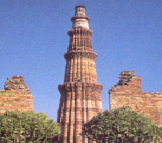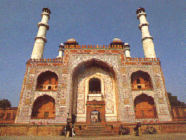Mahmud of Ghazni and Mohammed Ghori and their fanatical followers poured down across the Khyber and Bolan passes of the Himalayan ranges into the fertile Indo-Gangetic plains. The Hindu civilization meanwhile passed its prime by the 10th century of the Christian era. Shankaracharya was the last great philosopher of Hindu India. Artistic inspiration died up after 7th to 8th centuries so nothing like the Ajanta was created afterwards. The Last great Poet in Sanskrit was Kalidasa. Universities like Taxila and Nalanda stopped attracting brilliant minds from all over the world.
The feudal decline and the consequent degeneration of society paved way for foreign intervention. Mohmud Ghazni carried out 17 raids in northern India, but this shock treatment did not produce any unified plan of resistance among the Indian rulers. With the best horses the Afghans had no natural barriers once they passed the Khyber-Bolan passes. Alberuni, a great Arab Scholar was fascinated by the "Hindu" Indian thought .He recorded the Hindu_Arabic cultural interaction in many of his works. The Arab scholars adopted and popularized the Hindu Numerals, which are now called ARABIC NUMERALS the world over, 1including the concept of ZERO.
Conquest of India from the northwestern route by the Muslim dynasties is summarized and given below according to chronology.
| 712 A.D. | Arab conquest of Sind. |
| 997- 1030 A.D. | Raids of Mahmud of Ghazni. |
| 1192 A.D. |
Muhammad Ghori defeated Prithiviraj Chauhan. |
| 1206 A.D. | Slave dynasty established by qutb-ud-din -Aibak. |
| 1296- 1316 A.D. | Ala-ud-din Khilji's reign. |
| 1325- 51 A.D. | Muhammad bin Tughlak's reign. |
| 1414- 50 A.D. | Rule of Sayyids at Delhi. |
| 1451 A.D. | Accession of Bahlul Lodi |
| 1526 A.D. | First Battle of Panipat. Babur establishes the Mughal Empire. |
THE SULTANS:

QUTB MINAR - NEW DELHI
Then followed the Tughlugs who transferred the capital from Delhi to Devagiri in the South and they also introduced leather currency, which was a failure. By the 20th century the Muslims after 800 years of domination could convert only 25% of the population of India to Islam.
The Muslims could not rule without Hindu assistance, so many Hindus were inducted into the bureaucracy. This resulted in the development of a new common language, Urdu, which is now spoken in most parts of Northern India.
SOUTH INDIA IN HISTORY
In the absence of large-scale invasion, South India maintained equilibrium till the advent of British rule. The agrarian integration took place in South India in the beginning of the second millennium. The agricultural surplus in the Kaveri valley region projected Tanjore ,the Chola Capital under kings like Raja Raja, Rajendra and Kulothunga. In the 9th century of the Christian era great Tamil works like CHILAPADIKARAM, MANIMEGALAI AND JIVAKA CHINTAMANI were made. Since the west coast of India had a world monopoly of pepper, teak and spices, it attracted a lot of western adventurers.
Between 1000 and 1300 AD, the Hoysala Empire, which had centers in Belur, Halebid, and Somnathpur was at its peak. Meanwhile in northern Karnataka the Hindu kingdom of Vijayanagar was founded in 1336 by the famous brothers Harihara and Bukka. Its capital was Hampi and perhaps it was the strongest Hindu kingdom.
MUGHAL RULE

AKBAR'S MAUSOLEUM
Fatepur Sikri the monumental work of Akbar speaks of his vigor and dynamism. Akbar was probably the greatest of the Mughal Emperors, for he, not only had great military power but he was also a man of culture and wisdom.
Jahangir (1605-27) and Shahjahan (1527-59) who succeeded Akbar were both pleasure seekers, caring more for power and wealth than reforms and justice. The Mughal Empire is a unique phenomenon in the history of India and it was autocratic to the core. The Mughals had a great passion for monumental architectures. It didn't take long for revolts to take place on all sides and with Aurangazeb's death in 1707; the Mughal Empire's fortune began to decline sharply.


